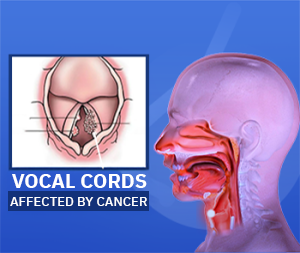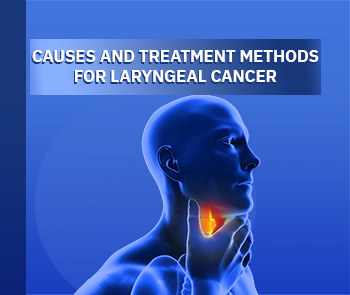Laryngeal Cancer

Laryngeal Cancer is a condition that affects the vocal cords, which are the source of the sound you produce every moment. However, what many people don’t know is that, like any other part of the body, the vocal cords can also face health issues, some of which are simple and resolve on their own quickly, while others are more serious.
Laryngeal cancer begins as small, abnormal-shaped cells, which start to grow uncontrollably. If diagnosed early, before it spreads to other parts of the larynx, the chances of recovery are high.
In this article, you will discover everything you need to know about laryngeal cancer in great detail.
- Causes of Laryngeal Cancer
- Symptoms of Laryngeal Cancer
- Diagnosis of Laryngeal Cancer
- Treatment of Laryngeal Cancer
- Prevention of Laryngeal Cancer
Causes of Laryngeal Cancer:
Laryngeal cancer occurs due to a genetic malfunction. Doctors notice that cancerous cells appear as red or white lesions on the tissue covering the vocal cords.
As the cancerous cells continue to divide, it can disrupt the function of the vocal cords and begin to spread to other parts of the larynx. The cancer can affect one or both vocal cords, and it can be easily detected early through exams and monitoring changes in the voice, such as hoarseness.
The number of cases diagnosed with laryngeal cancer is approximately 10,000 annually worldwide. Some of the factors that increase the risk of developing laryngeal cancer include:
- Smoking
- Excessive alcohol consumption
- A family history of head or neck cancers
- Overconsumption of red meat, processed, and fried foods
Symptoms of Laryngeal Cancer:
The following symptoms and signs may indicate the presence of cancer in the vocal cords:
- Hoarseness and voice changes lasting more than 3 weeks
- Shortness of breath
- Swelling in the neck
- Chronic sore throat
- Difficulty and pain while swallowing
- Occasional ear pain
- A sensation of something being stuck in the throat
- Changes in voice
- Chronic cough with blood
- Rapid weight loss
These symptoms do not necessarily indicate the presence of cancer in the vocal cords, but they should be treated as warning signs. It is important to seek advice from an ENT doctor to identify the underlying issue before it worsens. If diagnosed with laryngeal cancer, the patient should start treatment immediately to prevent further deterioration, which can lead to death.
Diagnosis of Laryngeal Cancer:
Laryngeal cancer is diagnosed through a comprehensive evaluation that includes:
- A physical examination based on the patient’s symptoms.
- Reviewing the patient’s medical history.
- Examination of the vocal cords using:
- Flexible Nasal Endoscopy: A thin camera is inserted through the mouth or nose to examine the voice box. If a suspicious growth or tumor is detected, a biopsy is taken. If cancerous cells are found in the biopsy results, further imaging such as CT scans, MRIs, or PET scans are done to locate and assess the cancer’s spread.
- Laryngeal Endoscopy: A camera with a light is used to provide a magnified view of the vibrating vocal cords.
- Flexible Nasal Endoscopy: A thin camera is inserted through the mouth or nose to examine the voice box. If a suspicious growth or tumor is detected, a biopsy is taken. If cancerous cells are found in the biopsy results, further imaging such as CT scans, MRIs, or PET scans are done to locate and assess the cancer’s spread.
If the tumor spreads to other areas of the larynx, cancer cells can invade lymph nodes on one or both sides of the neck. Early detection of laryngeal cancer helps prevent it from spreading to other parts of the throat.
Treatment of Laryngeal Cancer:
The goal of treating laryngeal cancer is to remove the tumor completely while preserving as many healthy cells as possible. The types of treatment depend on the tumor’s type, size, and the patient’s condition. Treatment methods include:
- Laser Treatment to remove tumors
- Surgical Intervention: This involves anesthesia and the use of small cameras and tools inserted through the mouth to remove the cancerous growth while preserving the healthy tissue in the vocal cords.
- Radiation Therapy: High-energy radiation is used to destroy cancer cells on and around the vocal cords and prevent their spread, while preserving healthy cell function.
- Chemotherapy: Chemotherapy may be used to target cancerous cells that have spread to other areas of the neck.
- Laryngectomy and Neck Surgery: In advanced stages, the larynx and cancerous lymph nodes may be removed.
It is important to remember that the chances of recovery from laryngeal cancer increase significantly when the disease is caught early and treated promptly.
Prevention of Laryngeal Cancer:
There are no definitive ways to prevent laryngeal cancer since its exact causes are not fully understood. However, since smoking is one of the primary causes, avoiding smoking can help reduce the risk of developing the disease.
Lastly, the duration of treatment and recovery varies for each patient depending on the stage of the disease and how the body responds to treatment. The earlier the cancer is diagnosed and treated, the higher the chance of recovery. However, in cases where the cancer has spread to other parts of the body, treatment becomes more complex and options become limited.







